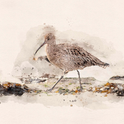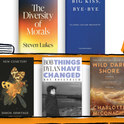The cover of a recent issue of Time featured an infant clutching a model of the double helix, under the headline: "The IQ Gene?" The magazine reported that Joe Tsien, a professor at Princeton, had engineered a strain of super-intelligent mice, simply by inserting a few extra copies of a single gene (which carries the code for a key protein involved in transmitting chemical signals between neurons in the brain). Employing a battery of psychological tests appropriately adapted to mice-finding hidden platforms in water tanks, sniffing out unfamiliar objects in cages, and so on-Tsien recognised that his genetically modified mice could store and recall information far better than their littermates. Accordingly, Tsien nicknamed his strain of supermice "Doogie," after the precocious title character of Doogie Howser, MD, a truly unmemorable American sitcom. Tsien's results, published in the journal Nature, leave no doubt that tinkering with the chemistry of the brain can boost short-term memory. In rodent terms, at least, that's enough to put you at the head of the bell curve.
It is fair to point out that Time also printed a comment by the evolutionary biologist Stephen Jay Gould, criticising the na?ve notion of a gene controlling IQ in humans. But the "Doogie" mice have become the latest scoring point in the tedious debate between those who argue that behaviour is genetically hardwired, and those who insist that cognitive development is the product of nurture, not nature. This fracas has been simmering for years, heated by a stream of media headlines invoking genes for almost every facet of human development and behaviour. While some of these claims have merit, others begin to sag under further scrutiny. Earlier this year, for example, Dean Hamer's celebrated "gay gene" hypothesis suffered a serious blow when a Canadian group failed to replicate his controversial 1993 findings.
Tedious or not, controversy about the role of genes in shaping human nature is intensifying as the race to decipher the complete sequence of the human genome-3 billion letters of DNA-reaches its conclusion in the next year or so. It is incontrovertible that the impact of identifying all 100,000 human genes will be profound on medicine, on our understanding of the human mind and on our view of humanity in general. So the arrival of Matt Ridley's book, Genome: The Autobiography of a Species in 23 Chapters, is well-timed. It offers one of the most perceptive and lively accounts of what we are learning-and might find out in the future-about the book of man.
Ridley's approach is simple yet effective: despite its billing as an "autobiography," Genome is actually a collection of 23 short stories. The central character in each chapter is just one of the genes found on the 23 pairs of human chromosomes, on which Ridley cleverly layers a mixture of historical, scientific and medical insights to illustrate a dazzling array of fundamental features of human biology. (There are actually thousands of genes on average per chromosome. Those genes are sections of DNA which lie along the chromosome rather like beads on a string.)
Ridley's rationale for the book was inspired by a discussion with a Harvard University evolutionary biologist, who said that his "favourite" chromosome was number 15-the home of a cluster of extraordinary genes whose activity depends on whether they are passed down from the father or mother. (In fact, many researchers acknowledge having "pet" chromosomes. MIT's Eric Lander, who trained as a mathematician, chose to sequence chromosome 17 for the Human Genome Project because he considers 17 to be the most interesting of all numbers.) So the story of chromosome 1 begins with a gene potentially implicated in the origin and evolution of life on earth. From here, the author embraces subjects as diverse as disease, personality, evolution, politics, conflict, free will and intelligence.
Over the years, some chromosomes have become almost synonymous with certain genes. One example is chromosome 4 and Huntington's disease (HD). The mutation which causes this fatal and incurable neurodegenerative disease was traced to chromosome 4 back in 1983. This early success was courtesy of the efforts of Nancy Wexler, a Columbia University researcher who collected hundreds of DNA samples from HD sufferers among the inhabitants of the shores of Lake Maracaibo, Venezuela. Wexler, whose mother died of HD, marshaled a group of the world's top geneticists in the ten-year quest for the gene. And yet despite finding the HD gene in 1993, the discovery simply produces more questions than answers. HD is a dominantly inherited disease, meaning that individuals have a 50 per cent chance of inheriting the gene if one of their parents was affected. Is it worth taking the simple genetic test to find out if you have inherited a fatal disease gene, or better to live with the uncertainty? Could a positive diagnosis at an early age (decades before symptoms materialise) lead to discrimination in getting a job or insurance? Wexler sums up these dilemmas with Tiresias's words to Oedipus: "It is but sorrow to be wise when wisdom profits not."
However, as Ridley stresses, "genes are not there to cause disease." Drawing on evolutionary psychology, molecular anthropology, and something called "psychoneuroimmunology," he paints a panoramic view of genes and their influence on personality, memory and language development, as well as delving into human pre-history and eugenics. The writing is crisp, amusing and provocative. Ridley argues uncompromisingly that the increase in asthma is attributable to today's modern, ultra-hygenic society which minimises exposure to mycobacteria, leaving the immune system in a precarious, hyperactive state. Later, while discussing stress, Ridley spotlights studies which purport to demonstrate that the incidence of cardiovascular disease is inversely proportional to job status-proof, Ridley asserts, that "your heart is at the mercy of your pay grade." This is an intriguing idea, but it is contradicted elsewhere in the book when Ridley correctly points out the importance of genes in influencing heart disease. Indeed, hereditary forms of heart disease such as familial hypercholesterolaemia and Tangier disease show unequivocally the importance of the body's handling of cholesterol for good health.
Ridley's "one-gene-per-chromosome" gambit only starts to unravel at the end of the book. In the final chapter on chromosome 22, Ridley conjures up a hypothetical gene with which to tackle the thorny subject of inheritance and free will. Ironically, scientists at the Sanger Centre in Cambridge (with colleagues in Japan and the US) have just celebrated the complete sequencing (ignoring a few gaps left for technical reasons) of this small chromosome-a major landmark in the history of the Genome Project. The cataloguing of almost 1,000 genes along this chromosome should enable researchers to identify genes for cancer, schizophrenia and many other disorders in the next year or so.
The director of the Genome Project, Francis Collins, says that the work is more important than the moon landings and the Manhattan Project. But despite leading an international alliance of researchers (in Cambridge, Japan and the US) supported largely by the National Institutes of Health and the Wellcome Trust, Collins is desperately fending off a dramatic late bid to pirate the sequence by Craig Venter, a brash, rich, smart American DNA sequencer. Armed with some 300 state-of-the-art DNA sequencing machines and an $80m Compaq supercomputer to assemble millions of DNA sequences, Venter's new company, Celera Genomics, predicts that it can complete the sequence within a year or two, snapping up the patent rights to thousands of genes in the process.
No matter who wins this race, decoding human DNA paves the way for monumental advances in medical research. While the identification of 100,000 genes will be an important landmark in human history, equally important will be the description of millions of variations in the DNA which exist between any two individuals. It is these seemingly trivial variations which control the activity of our genes, sculpting each person's unique physical appearance and mental development. Within ten to 20 years, doctors could be handing patients a CD-rom containing their complete DNA sequence, along with a detailed profile of present and future health risks and customised medicines. The drug industry is staking hundreds of millions of pounds on genome research to boost drug discovery and match the best drugs for a patient's genetic make-up.
As biomedical research races into the post-genomic era, there will be many more claims for new genes underpinning different elements of human behaviour. Ridley, however, dismisses concerns that the discovery of personality genes could one day usher in a brave new world of human genetic engineering. He argues that there are simply too many genes involved. But arguments that human ingenuity will be thwarted by failings of technology are seldom convincing, and one should not underestimate the will of the people. James Watson, co-discoverer of the double helix, once said: "If we could promise young couples that we knew how to give them offspring with superior character, why should we assume they would decline? If scientists find ways greatly to improve human capabilities, there will be no stopping the public from happily seizing them."
Then again, despite the best efforts of genetics research, there are undoubtedly elements of human behaviour which will never be spelled out in the digital DNA code. As the slogan for the science-fiction film Gattaca put it: "There is no gene for the human spirit."
Genome: the autobiography of a species in 23 chapters
Matt Ridley
Fourth Estate 1999, ?18.99











